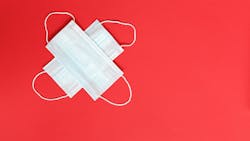Screening tool for healthcare workers help identify COVID-19 cases
Mass General Brigham developed and launched COVID Pass, a daily attestation tool that has been used to record more than 15 million attestations since its inception. The tool asks employees to attest to the fact that they do not have symptoms of illness, such as fever, chills, cough, or shortness of breath.
But how well do attestation tools like COVID Pass work in catching symptomatic employees before they walk through the door and potentially transmit the virus to others? A new analysis led by investigators at Brigham and Women’s Hospital assessed the effectiveness of daily symptom attestation for healthcare providers across the Mass General Brigham system, according to a news release from the organization.
Rates of cases were low, but more than 100 employees who attested to symptoms using COVID Pass went on to test positive for COVID-19, reflecting the tool’s potential for preventing transmission events. Results are published in Infection Control & Hospital Epidemiology.
“When the COVID-19 pandemic began, we wanted to take every step possible to make sure that our employees weren’t bringing COVID-19 into the hospital,” said Hojjat Salmasian, MD, MPH, PhD, of the Brigham’s Division of General Internal Medicine. “COVID Pass is just one of many layers of protection, but it does give employees a moment to pause and evaluate themselves. And if they do attest to symptoms, the tool immediately prompts them to get tested and directs them to resources for how and where they can get that test done.”
The research team evaluated more than 2 million attestations over 99 days between March 23, 2020, and June 30, 2020, during the height of the pandemic in the Boston area. These included attestations from more than 65,000 employees across 52 hospitals and clinic sites within the Mass General Brigham system. Employees who came to campus were screened daily before being permitted on-site and those who attested to at least one symptom were referred to Occupational Health Services for further evaluation, including testing if indicated, before being cleared for work. Health care providers could also contact Occupational Health daily or get tested if they were concerned about exposure or symptoms.
Of the 2 million attestations evaluated, 99.9% reported no symptoms. There were 2,062 employees who attested to at least one symptom, with the most common symptom being sore throat (reported in 25% of symptomatic attestations). Of these, 905 employees were tested within 14 days and 114 (13%) tested positive for COVID-19.
During the same time period, 1,289 employees tested positive for COVID-19. During the two weeks before their positive test, 9% had attested to symptoms, 58% had no symptoms, and 33% had not completed an attestation. Investigators identified this last group as potentially concerned employees skipping attestation and directly calling Occupational Health or independently scheduling a test. Employees only submitted attestations if they were planning to come in to work in a clinical setting.
For healthcare workers who attested to symptoms, the research team cross-correlated that data with lab results from tests conducted at a Mass General Brigham facility — if the person was tested elsewhere, their data would not have been captured in the study. The authors also note that attestation occurs before a person arrives at work — if symptoms developed over the course of the day, that may not have been reflected in their attestation.

